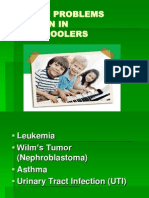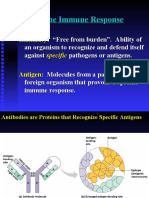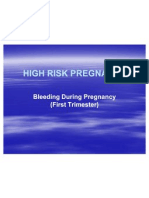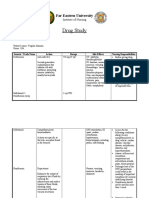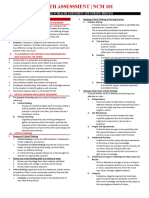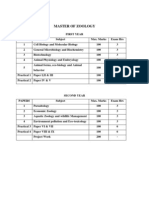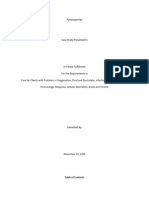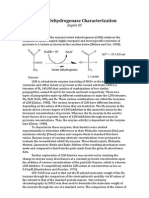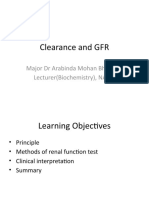Pathophysiology Notes - Inflammation and Healing
Pathophysiology Notes - Inflammation and Healing
Uploaded by
KateCopyright:
Available Formats
Pathophysiology Notes - Inflammation and Healing
Pathophysiology Notes - Inflammation and Healing
Uploaded by
KateOriginal Description:
Copyright
Available Formats
Share this document
Did you find this document useful?
Is this content inappropriate?
Copyright:
Available Formats
Pathophysiology Notes - Inflammation and Healing
Pathophysiology Notes - Inflammation and Healing
Uploaded by
KateCopyright:
Available Formats
lOMoARcPSD|3150697
- Unmyelinated fibers - Existing, chemical
- Paleospinothalamic Stress response:
tract Long-term, Disabling, Fatigue, Depression, Irritability
Emotion: Loss of hope, anger
Pain – Chapter 13 (continued)
Two main classes of pain medication act at different locations:
Non-steroidal Inflammatory Drugs (NSAIDs) Act at the peripheral level
Opioids Act at the central nervous system (CNS) level
Causes Pain may be felt d/t inflammation, infection, ischemia, tissue necrosis, stretching of tissue,
chemicals or burns.
Skeletal muscle Pain may result from ischemia or hemorrhage
Somatic Pain May arise from the skin (cutaneous) or deeper structures – such as bones or muscles –
Conducted my sensory nerves
Visceral Pain Originates from the organs
Travels by sympathetic fibres.
*Transmission of pain senses
The peripheral nerves transmit the afferent pain impulses to the Dorsal root ganglia then
into the spinal cord through the dorsal horn or substantia gelantinosa
Inflammation & Healing – Chapter 2
Inflammation The body’s nonspecific response to tissue injury resulting in:
redness
warmth
edema
pain
*loss of function
General signs and symptoms serve as a warning
Downloaded by Kate Staple (kathryn.stapleton@qc.quincycollege.edu)
lOMoARcPSD|3150697
Inflammation is not the same as infection – although, infection is one of the causes of
inflammation.
With infection microorganisms such as: Bacteria, viruses, and fungi – are always present at the site –
causing inflammation,
When inflammation is caused by an allergy or a burn no microbes are present
Normal:
1) Blood flow Normal fluid shift protein remains in blood & water electrolytes, glucose
into interstitial fluid Cells remain in blood
Inflammation:
1) Injury Cells release chemical mediators Vasodilation – increases blood flow Increased
capillary permeability Leukocytes move to the site of injury Macrophages - Phagocytosis
– removal of debris in preparation for healing
Acute Inflammation
Pathophysiology
Inflammation may develop immediately and last only a short period of time may have a delayed
onset. (e.g. sunburn) or it may be more severe and ongoing
The severity is based on the cause and the amount of exposure
Chemical Source Major Action
Histamine Mast cell granules Immediate vasodilation and
increased capillary permeability to
Downloaded by Kate Staple (kathryn.stapleton@qc.quincycollege.edu)
lOMoARcPSD|3150697
form exudate
Chemotactic factors Mast cell granules Attract neutrophils to the site
Platelet-activating factor (PAF) Cell membranes of platelets Activate neutrophils
Platelet aggregation
Cytokines T-lymphocytes Increase plasma proteins
ESR
Macrophages Induce fever, chemotaxis,
leukocytosis
Leukotrienes Synthesis from arachidonic acid in Later response: Vasodilation &
mast cells increased capillary permeability
chemotaxis
Prostaglandins (PGs) Synthesis from arachidonic acid in Vasodilation and increased capillary
mast cells permeability, pain, fever,
potentiate histamine effect
Kinins (e.g. bradykinin) Activation of plasma protein Vasodilation and increased capillary
(e.g. kinogen) permeability, pain, chemotaxis
Complement System Activation of plasma protein Vasodilation and increased capillary
cascade permeability, chemotaxis, increase
histamine release
Chemical mediators include: histamine, serotonin, prostaglandins, and leukotrienes into the
interstitial fluid and blood
These chemicals affect blood vessels and nerves in the damaged area
Cytokines serve as communicators in the tissue fluids sending messages to lymphocytes and
macrophages, the immune system, or the hypothalamus to induce fever
Local vasodilation: relaxation of smooth muscle causing an increase in the diameter of
arterioles which causes hyperemia (increased blood flow in the area)
Capillary permeability also increases allowing plasma proteins to move into the interstitial
space along with more fluid
- The increased fluid dilutes any toxic material at the site while globulins serve as antibodies
- Fibrinogen attempts to localize the site by providing a fibrin mesh
Function of Cellular Elements in the Inflammatory Response
Leukocytes Activity
1) Neutrophils Phagocytosis of microorganisms
2) Basophils Release of histamine leading to inflammation
3) Eosinophils Numbers are increased in allergic responses
Lymphocytes Activity
1) T-Lymphocytes Active in cell-mediated immune response
2) B-Lymphocytes Produces antibodies
3) Monocytes Phagocytosis
4) Macrophages Active in phagocytosis. These are mature
monocytes that have migrated into tissues from
the blood
Downloaded by Kate Staple (kathryn.stapleton@qc.quincycollege.edu)
lOMoARcPSD|3150697
Cardinal Signs of Inflammation Causes/Effects
Redness and warmth Increased blood flow to the area (hyperemia)
Swelling (edema) Shift of protein and fluid into the interstitial
space
Pain Increased pressure from fluids exerted onto the
nerve endings (e.g. bradykinins)
*Loss of function Lack of nutrition or swelling interferes
mechanically with function – restricts joint
movement
Exudate refers to a collection of interstitial fluid formed in the inflamed area
Type of exudate Description Example
Serous Watery – consist primarily of fluid with small Allergic reactions and burns
amounts of proteins and WBCs
Fibrinous Thick and sticky – have a high cell and fibrin Class Notes:
content
- Increases the risk of scar tissue in the area
Purulent Thick, yellow-greenish in color Indicates bacterial infection
Contains more leukocytes, cell debris, and
microorganisms
Referred to “pus”
Abscess Localized pocket of purulent exudate or pus in Around the tooth or the brain
solid tissue
Hemorrhagic Present in damaged blood
vessels
Systemic Effects of Inflammation Class Notes
Mild fever (pyrexia)
Malaise (feeling unwell)
Fatigue
Headache
Anorexia (Loss of appetite)
Leukocytosis
Inflammation & Healing – Chapter 2 (continued)
Changes in the blood with Inflammation Description
Leukocytosis Increased numbers of WBCs especially,
neutrophils
Differential count Proportion of each type of WBC altered
8
Downloaded by Kate Staple (kathryn.stapleton@qc.quincycollege.edu)
lOMoARcPSD|3150697
depending on the cause
Plasma proteins Increased fibrinogen and prothrombin
C-reactive protein A protein not normally in the blood appears w/
acute inflammation and necrosis within 24-48hrs
Increased Erythrocyte Sedimentation Rate (ESR) Elevated plasma proteins increase the rate at
which RBCs settle in a sample
Cell enzymes Released from necrotic cells and enter tissue fluids
and blood may indicate site of inflammation
A granuloma a small mass of cells with a necrotic center and covered by connective tissue may
develop around a foreign object (e.g. splinter) or part of the immune response in some infections
such as tuberculosis
Healing
Types of Healing Description Example/Class Notes
Resolution The process that occurs when there is After a mild burn
minimal tissue damage.
The damaged cells recover, the tissues
return to normal within a short period of
time
Regeneration Healing process that occurs in damaged Some type of cells – epithelial –
tissue in which the cells are capable of are constantly replicating
mitosis
Replacement Replaced by connective tissue (scar or Brain tissue or myocardium
fibrous tissue formation)
Takes place when there is extensive tissue
damage or the cells are incapable of mitosis
*Healing by first intention Refers to the process involved when the This type of healing is seen in
wound is clean, free of foreign material and some surgical incisions
necrotic tissue, and the edges of it are held
close together creating a minimal gap
between the edges
*Healing by second intention Refers to a situation in which there is a A compound fracture would
large break in the tissue and consequently heal in this manner
more inflammation a longer healing
process and formation of more scar tissue
Inflammation & Healing – Chapter 2 (continued)
The Healing Process
The process of tissue repair begins following injury when a blood clot forms and seals the area
- After 3 to 4 days foreign material and cell debris have been removed by phagocytes,
monocytes, and macrophages
- Granulation tissue grows into the gap from nearby connective tissue granulation tissue is
highly vascular and appears moist and pink or red in color it contains many new capillary
9
Downloaded by Kate Staple (kathryn.stapleton@qc.quincycollege.edu)
lOMoARcPSD|3150697
buds from the surrounding tissue very fragile and is easily broken down by microorganisms or
stress on the tissue
- Wound cavity is being filled in, nearby epithelial cells undergo mitosis, extending across the
wound from the outside edges inward
- Collagen a protein that is the basic component of scar tissue and provides strength for the
new repair
Factors Affecting Healing
A small gap in the tissue results in complete healing within a short period of time with minimal scar
tissue formation
- A large or deep area of tissue damage requires a prolonged healing time results in a larger
scar
Complications of healing by scar formation
Loss of function
Loss of function results from the loss of normal cells and the lack of specialized structures or normal
organization in scar tissue
- For example if scar tissue replaces normal skin, that area will lack hair follicles, glands, and
sensory nerve endings.
Contractures or Obstructions
Scar tissue is nonelastic and tends to shrink over time
Fixation and deformity of the joint a conditional referred to as contracture
Adhesions
Bands of scar tissue joining two surfaces that are normally separated
Hypertrophic Scar Tissue
Overgrowth of fibrous tissue consisting of excessive collage deposits may develop leading to hard
ridges of scar tissue or keloid formation
Ulceration
Blood supply may be impaired around the scar resulting in further tissue breakdown and ulceration
Types of microorganisms
Bacteria
Bacteria are unicellular (single cell) organisms that do not require living tissue to survive
The major groups of bacteria are:
10
Downloaded by Kate Staple (kathryn.stapleton@qc.quincycollege.edu)
You might also like
- Huberman Sleep ToolkitDocument3 pagesHuberman Sleep Toolkittayyab.zaidiNo ratings yet
- Short Table of Muscle Control Exercises - The MaxaldingDocument48 pagesShort Table of Muscle Control Exercises - The MaxaldingHugo Mantilla90% (10)
- Cardiac Lecture NotesDocument10 pagesCardiac Lecture NotesKateNo ratings yet
- Module 6 - Review AnswersDocument3 pagesModule 6 - Review AnswersKate100% (1)
- Physiological Changes in Elderly RespiDocument23 pagesPhysiological Changes in Elderly RespiIrwan M. IskoberNo ratings yet
- NCM112 Module 2 Day 2 Immune SystemDocument12 pagesNCM112 Module 2 Day 2 Immune SystemAndrea DaracanNo ratings yet
- Kozier Nanda PDFDocument1 pageKozier Nanda PDFanindcNo ratings yet
- 6-Health Problems Common in PreschoolerDocument36 pages6-Health Problems Common in PreschoolerPam Lala100% (2)
- MNT Hematological System ReviewerDocument6 pagesMNT Hematological System ReviewerTrishia Delos Santos AfundarNo ratings yet
- Management of Patients With Immune Deficiency DisordersDocument11 pagesManagement of Patients With Immune Deficiency DisordersmasheennavirgoNo ratings yet
- Tonsillitis and AdenoiditisDocument12 pagesTonsillitis and AdenoiditisHannah Angelu CabadingNo ratings yet
- NCM 106 Cellular-AberrationDocument6 pagesNCM 106 Cellular-AberrationJoanne TolopiaNo ratings yet
- EmphysemaDocument29 pagesEmphysemaMisheel OrgilsaikhanNo ratings yet
- Week 2-3 Part 1Document26 pagesWeek 2-3 Part 1EmpieNo ratings yet
- Common Health Problems InfancyDocument147 pagesCommon Health Problems Infancymark OrpillaNo ratings yet
- M1 - Urinary DisordersDocument2 pagesM1 - Urinary DisordersjuiceNo ratings yet
- Inflammation of CNSDocument38 pagesInflammation of CNSTauqeer AhmedNo ratings yet
- Theories of Aging 2022Document12 pagesTheories of Aging 2022Lara Victoria DuenasNo ratings yet
- Immunologic ResponsesDocument44 pagesImmunologic ResponsesRoslinda Bt Abd Razak100% (2)
- Pediatric Nursing or Child Health NusrsingDocument20 pagesPediatric Nursing or Child Health NusrsingGenynne RagasaNo ratings yet
- Ink NCM 110-Immunologic Response 8-23-20Document60 pagesInk NCM 110-Immunologic Response 8-23-20Justin John NavarroNo ratings yet
- Disorders of The Immune Response and Inflammation 3Document47 pagesDisorders of The Immune Response and Inflammation 3Cres Padua QuinzonNo ratings yet
- Assessment of A Pregnant FamilyDocument4 pagesAssessment of A Pregnant FamilyLuna Sang-anNo ratings yet
- Pa Tho Physiology of TuberculosisDocument3 pagesPa Tho Physiology of TuberculosisFlauros Ryu JabienNo ratings yet
- Resource AllocationDocument17 pagesResource AllocationkarynaNo ratings yet
- High Risk NewbornDocument10 pagesHigh Risk NewbornEmmy Flor ValmoriaNo ratings yet
- Maternal and Child Care Nursing Module 1Document90 pagesMaternal and Child Care Nursing Module 1Andrea Monique R. Galasinao100% (1)
- Diabetic Nephropathy: Regional Morbidity: Ten (10) Leading CausesDocument3 pagesDiabetic Nephropathy: Regional Morbidity: Ten (10) Leading CausesMarielle ChuaNo ratings yet
- Immune FinalDocument53 pagesImmune FinalJaylord VerazonNo ratings yet
- NCM 109 Problems With Power DraftDocument3 pagesNCM 109 Problems With Power DraftJP Porras Ali100% (1)
- DS - CatapresDocument2 pagesDS - CatapresDOni CorleoneNo ratings yet
- PATHOPHYSIOLOGYDocument4 pagesPATHOPHYSIOLOGYThea Lacaba AbosamaNo ratings yet
- Appendix A: National Unified Health Research Agenda A. DiagnosticsDocument10 pagesAppendix A: National Unified Health Research Agenda A. DiagnosticsKit ChampNo ratings yet
- Immunologic and Infectious DisordersDocument38 pagesImmunologic and Infectious Disordersdarla ryanNo ratings yet
- Chapter 19 Pediatric Diseases and DisordersDocument5 pagesChapter 19 Pediatric Diseases and DisordersCelestine Kate Audi ٿNo ratings yet
- Are Viruses Living or Non-Living Organisms?Document8 pagesAre Viruses Living or Non-Living Organisms?Sydney Cloyce NagalNo ratings yet
- Maternal and Child Lec Reviewer 1 8Document10 pagesMaternal and Child Lec Reviewer 1 8Keziah Marie Chua Santa-AnaNo ratings yet
- Common Health Issues in School-Age and AdolescentDocument27 pagesCommon Health Issues in School-Age and AdolescentKlare MontefalcoNo ratings yet
- Cardiovascular Agents ReviewerDocument18 pagesCardiovascular Agents ReviewerJoycel CeñidozaNo ratings yet
- The Child With Hematologic DisordersDocument149 pagesThe Child With Hematologic DisordersNics FranciscoNo ratings yet
- PathophysiologyDocument1 pagePathophysiologyAngely Dianne Santiago IINo ratings yet
- 3.3 Family PlanningDocument9 pages3.3 Family PlanningGayle Regine DaquialNo ratings yet
- Chapter 2 Lesson 1 and 2Document14 pagesChapter 2 Lesson 1 and 22C1 - YABES, JenniferNo ratings yet
- Gi PharmacologyDocument54 pagesGi Pharmacologyyohanes fikaduNo ratings yet
- SUBFERTILITYDocument46 pagesSUBFERTILITYLalisaM Activity100% (1)
- Mark Fredderick R. Abejo RN, MAN: Maternal and Child Nursing BulletsDocument9 pagesMark Fredderick R. Abejo RN, MAN: Maternal and Child Nursing BulletsCrystal Ann Monsale TadiamonNo ratings yet
- Bleeding Disorders of PregnancyDocument66 pagesBleeding Disorders of PregnancyDivine Flores-CamposNo ratings yet
- Aging Perspective and Demography Ncm114 Gerontology Aging PerspectivesDocument19 pagesAging Perspective and Demography Ncm114 Gerontology Aging PerspectivesLeslie CruzNo ratings yet
- MS2 EarsDocument8 pagesMS2 Earswieka mawieNo ratings yet
- Drug Study: Far Eastern UniversityDocument3 pagesDrug Study: Far Eastern UniversityChoy DacanayNo ratings yet
- Pharmacology - Section 23 - Antibiotics 2Document5 pagesPharmacology - Section 23 - Antibiotics 2Pathalee ThalpavilaNo ratings yet
- Care of The NewbornDocument5 pagesCare of The Newbornbuzz Q100% (2)
- The EyeDocument8 pagesThe Eyezyrine jhen100% (1)
- Nurses Role in Health Assessment and Nursing ProcessDocument9 pagesNurses Role in Health Assessment and Nursing ProcessJasmine MayeNo ratings yet
- Fundamentals of Nursing PracticeDocument40 pagesFundamentals of Nursing PracticeLendell Kelly B. YtacNo ratings yet
- The Newborn Care: Fcnlxa - St. Luke's College of NursingDocument10 pagesThe Newborn Care: Fcnlxa - St. Luke's College of NursingFrancine LaxaNo ratings yet
- Pediatric DisorderDocument35 pagesPediatric DisorderDenaise MarieNo ratings yet
- (Pharma) Cardio QuestionnaireDocument38 pages(Pharma) Cardio QuestionnaireMarqxczNo ratings yet
- FNCP Form Health Deficit AsthmaDocument3 pagesFNCP Form Health Deficit Asthmakappa100% (1)
- Newborn Physical AssessmentDocument2 pagesNewborn Physical AssessmentEunice May Saban AldaNo ratings yet
- The Ride of Your Life: What I Learned about God, Love, and Adventure by Teaching My Son to Ride a BikeFrom EverandThe Ride of Your Life: What I Learned about God, Love, and Adventure by Teaching My Son to Ride a BikeRating: 4.5 out of 5 stars4.5/5 (2)
- COMPREHENSIVE NURSING ACHIEVEMENT TEST (RN): Passbooks Study GuideFrom EverandCOMPREHENSIVE NURSING ACHIEVEMENT TEST (RN): Passbooks Study GuideNo ratings yet
- Ventricular Septal Defect, A Simple Guide To The Condition, Treatment And Related ConditionsFrom EverandVentricular Septal Defect, A Simple Guide To The Condition, Treatment And Related ConditionsNo ratings yet
- The politics of hunger: Protest, poverty and policy in England, <i>c.</i> 1750–<i>c.</i> 1840From EverandThe politics of hunger: Protest, poverty and policy in England, <i>c.</i> 1750–<i>c.</i> 1840No ratings yet
- Inflammation: Deske MuhadiDocument36 pagesInflammation: Deske MuhadiYUSMAWATI YUSRANNo ratings yet
- Week 2 Study GuideDocument14 pagesWeek 2 Study GuideKateNo ratings yet
- Heme Review QuesDocument10 pagesHeme Review QuesKateNo ratings yet
- GERD (Heart Burn) : Gastrointestinal DisordersDocument7 pagesGERD (Heart Burn) : Gastrointestinal DisordersKateNo ratings yet
- Disease Cause Pathophysiology Signs and Symptoms Complications/TreatmentDocument6 pagesDisease Cause Pathophysiology Signs and Symptoms Complications/TreatmentKateNo ratings yet
- Bat Poems and InformationDocument8 pagesBat Poems and Informationapi-231480872No ratings yet
- Axial and Appendicular MusclesDocument10 pagesAxial and Appendicular MusclesYasmeen AlnajjarNo ratings yet
- Signal LearningDocument3 pagesSignal LearningJan Lemuel Fortaleza RefuncionNo ratings yet
- VACUETTE Preanalytics Manual en Rev06 0922 WebDocument47 pagesVACUETTE Preanalytics Manual en Rev06 0922 Webbassam alharaziNo ratings yet
- EJD Physical Assessment Head To ToeDocument4 pagesEJD Physical Assessment Head To ToeErl DrizNo ratings yet
- Stu GeronDocument5 pagesStu GeronefasaravananNo ratings yet
- Experiencing The Original You - KundaliniDocument2 pagesExperiencing The Original You - KundaliniErica Yang100% (1)
- 12 - Nucleotide MetabolismDocument53 pages12 - Nucleotide MetabolismFrankenstein MelancholyNo ratings yet
- Eaap8674 FullDocument12 pagesEaap8674 FullRajesh SudiNo ratings yet
- NUR100 Sherpath CH 44 PainDocument23 pagesNUR100 Sherpath CH 44 Paincaloy2345caloyNo ratings yet
- Concept 3 Notes - Endocrine System For StudentsDocument14 pagesConcept 3 Notes - Endocrine System For StudentsKaranNo ratings yet
- The Five KingdomsDocument4 pagesThe Five KingdomsKosh MatthewNo ratings yet
- M SC ZoologyDocument17 pagesM SC ZoologybiobiobioNo ratings yet
- Pyelonephritis - Case StudyDocument31 pagesPyelonephritis - Case StudygwynethntpNo ratings yet
- LKPD Digestive-System PDFDocument3 pagesLKPD Digestive-System PDFLala SiibolaNo ratings yet
- INBO 2017 SolutionDocument10 pagesINBO 2017 Solutionmasykur spensaNo ratings yet
- How To Interpret BGADocument24 pagesHow To Interpret BGASondang Herikson PanjaitanNo ratings yet
- ReferencesDocument32 pagesReferencesLususNo ratings yet
- Josephine Ann J. Necor, RNDocument37 pagesJosephine Ann J. Necor, RNAzura LiswaniNo ratings yet
- Lactate Dehydrogenase CharacterizationDocument23 pagesLactate Dehydrogenase CharacterizationAngela Kc100% (3)
- Vardenafil Hydrochloride - LevitraDocument51 pagesVardenafil Hydrochloride - Levitrasnn123456No ratings yet
- Theories of Labor: Prepared By: Ronarica B. Diones, R.N., R.MDocument17 pagesTheories of Labor: Prepared By: Ronarica B. Diones, R.N., R.MDee BorreroNo ratings yet
- Clearance and GFR: Major DR Arabinda Mohan Bhattarai Lecturer (Biochemistry), NAIHSDocument25 pagesClearance and GFR: Major DR Arabinda Mohan Bhattarai Lecturer (Biochemistry), NAIHSChandan SahNo ratings yet
- 2017 Cannabis en OncologiaDocument4 pages2017 Cannabis en OncologiaErvin Seborga100% (1)
- Kingdom AnimaliaDocument13 pagesKingdom AnimaliaAryanNo ratings yet
- Bot 20 Ex 6Document30 pagesBot 20 Ex 6Kath Valad-onNo ratings yet
- Cephalometric AnalysisDocument70 pagesCephalometric AnalysisUmer KhayyamNo ratings yet







